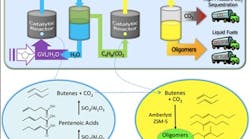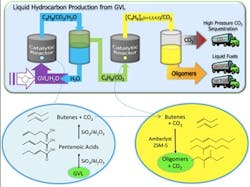A two-step process starting with ϒ-valerolactone (GVL) can efficiently produce liquid alkenes suitable for jet fuel and gasoline, say researchers at the University of Wisconsin, Madison, Wis. The route could spur large-scale production of both GVL and its precursor, biomass-derived levulinic acid, hopes James Dumesic, professor of chemical and biological engineering and lead researcher.
The process addresses two issues that can affect the economic and environmental attraction of biofuels -- external hydrogen requirements and carbon dioxide emissions, the researchers note. Converting GVL to alkenes doesn't require an outside supply of hydrogen. The CO2 produced in the process is at elevated pressure, which eases capture or use to make methanol or polycarbonates.
GVL itself can serve as a blending stock for gasoline and performs comparably to ethanol but suffers from limitations that blunt such widespread direct use, say the researchers. It has high water solubility, can only be used up to a certain level with conventional combustion engines, and provides lower energy density than petroleum-derived fuels. In addition, combustion of GVL releases more CO2 than alkenes would.
Reducing GVL with hydrogen to produce methyltetrahydrofuran can at least partially alleviate such limitations, the researchers note. However, using GVL to make liquid alkenes makes more sense, they contend, because this avoids the need for external hydrogen and provides a way to tailor molecular weight to fuel requirements.
In the process (Figure 1), GVL in an aqueous feed stream is decarboxylated at 36 bar in a fixed-bed reactor using a silica/alumina catalyst to yield equimolar amounts of butene and carbon dioxide. The exiting gas stream goes to a condenser to remove the water and then to an oligomerization reactor containing a solid acid catalyst. There, butene monomers are coupled to form condensable alkenes; process conditions can be tuned to yield alkenes of molecular weights and degrees of branching suitable for jet fuel and gasoline applications, say the researchers. The stream from this reactor goes to a condenser where it's split into liquid alkenes and CO2 gas.
Sponsored Recommendations
Sponsored Recommendations



